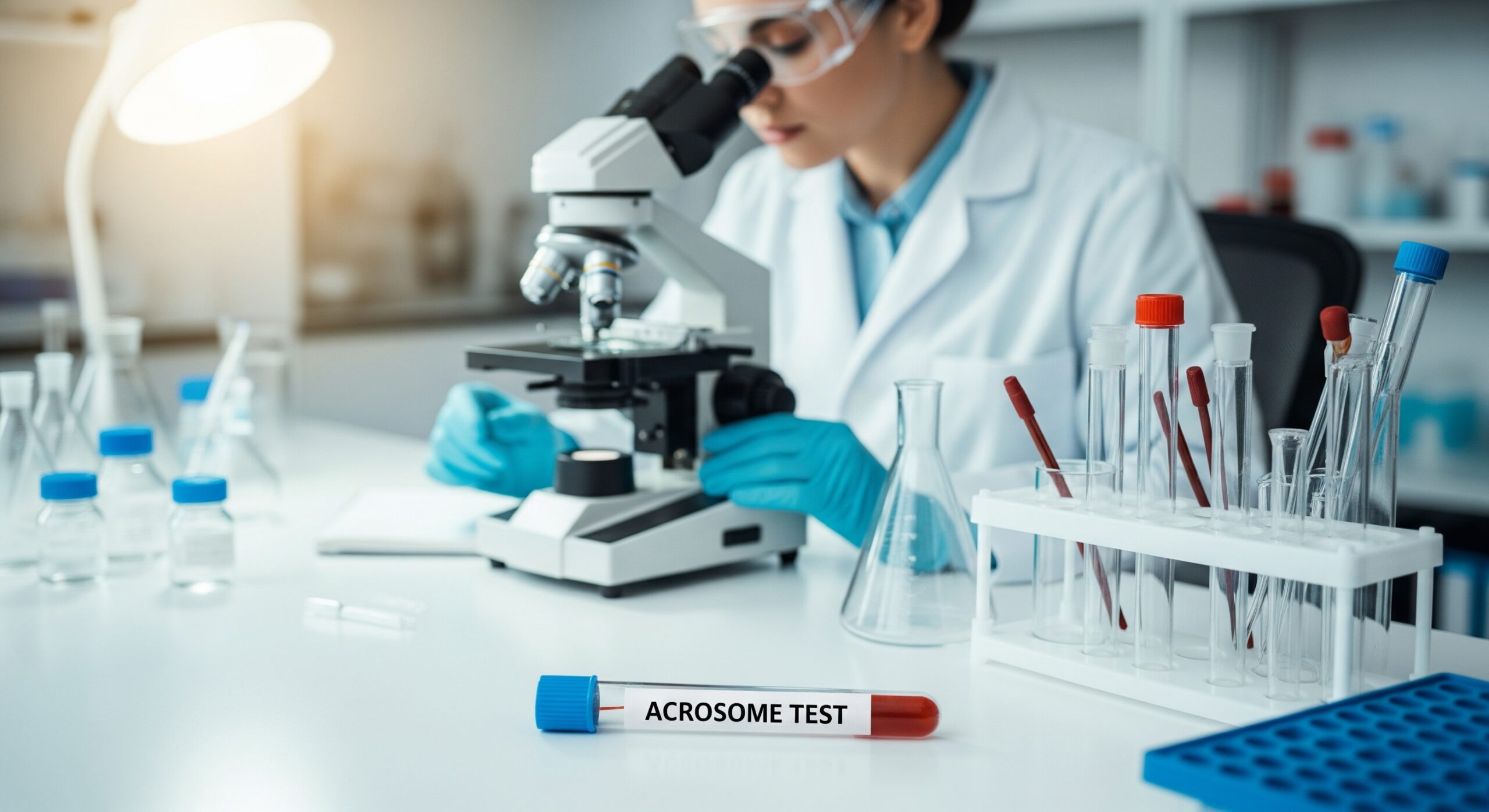When it comes to getting pregnant, sperm has one big job: reach and fertilize the egg. But there’s a tiny structure on the head of the sperm that makes this possible—the acrosome. So, what’s the role of the acrosome in a successful pregnancy?
Think of it as the sperm’s “drill.” It contains enzymes that help the sperm break through the egg’s protective layer so fertilization can happen. Without a properly functioning acrosome, even the healthiest sperm might not succeed. In this article, we’ll explain how the acrosome works, why it’s important, and what happens when it doesn’t do its job.
Role of the Acrosome in a Successful Pregnancy
Function of the Acrosome
The acrosome is a cap-like structure that covers the anterior part of the sperm’s head. It contains enzymes that are essential for penetrating the outer layers of the egg. These enzymes help the sperm to break down the protective barriers surrounding the egg, facilitating successful fertilization. Without a properly functioning acrosome, the sperm would struggle to reach and fertilize the egg.
- Contains enzymes crucial for egg penetration
- Facilitates sperm’s journey through the egg’s protective layers
- Essential for successful fertilization
Acrosome Reaction Process
The acrosome reaction is a critical step in fertilization. It involves the release of enzymes from the acrosome when the sperm comes into contact with the egg’s outer layer, known as the zona pellucida. This reaction allows the sperm to penetrate the zona pellucida and reach the egg’s plasma membrane. The acrosome reaction is a highly regulated process, ensuring that only one sperm fertilizes the egg.
- Triggered by contact with the zona pellucida
- Involves enzyme release for penetration
- Ensures single sperm fertilization
Importance of the Acrosome in Fertilization
The acrosome’s role in fertilization cannot be overstated. It is the key to breaking through the egg’s defenses, allowing the sperm to deliver its genetic material. Without the acrosome, fertilization would be nearly impossible, highlighting its importance in a successful pregnancy.
- Key to breaking the egg’s defenses
- Delivers sperm’s genetic material
- Crucial for a successful pregnancy
Sperm Morphology and Acrosome Structure
Normal Acrosome Anatomy
A healthy acrosome is vital for sperm function. It is typically a well-defined cap that covers the sperm’s nucleus. The acrosome’s structure is designed to store and release enzymes efficiently, ensuring the sperm can penetrate the egg’s outer layers.
- Well-defined cap structure
- Covers sperm’s nucleus
- Stores and releases enzymes efficiently
Abnormalities in Acrosome Formation
Abnormalities in acrosome formation can lead to fertility issues. These abnormalities may include malformed acrosomes or incomplete enzyme content, which can hinder the sperm’s ability to fertilize the egg. Understanding these abnormalities is crucial for diagnosing and treating infertility.
Acrosome Reaction and Fertilization
Triggers for Acrosome Reaction
The acrosome reaction is triggered by specific signals when the sperm encounters the zona pellucida. These signals initiate the release of enzymes, allowing the sperm to penetrate the egg’s protective layers. Understanding these triggers is essential for studying fertilization.
- Triggered by zona pellucida contact
- Initiates enzyme release
- Essential for studying fertilization
Zona Pellucida Penetration
Penetrating the zona pellucida is a critical step in fertilization. The enzymes released during the acrosome reaction digest the zona pellucida, allowing the sperm to reach the egg’s plasma membrane. This step is crucial for successful fertilization.
- Critical step in fertilization
- Enzymes digest zona pellucida
- Allows sperm to reach egg’s membrane
Fusion with Egg Membrane
After penetrating the zona pellucida, the sperm must fuse with the egg’s plasma membrane. This fusion allows the sperm to deliver its genetic material into the egg, completing the fertilization process. The acrosome plays a vital role in facilitating this fusion.
- Sperm fuses with egg’s membrane
- Delivers genetic material
- Completes fertilization process
Acrosome Disorders and Infertility
Common Acrosome-Related Issues
Acrosome-related issues can lead to infertility. Common problems include acrosome malformation, enzyme deficiencies, and failure to undergo the acrosome reaction. These issues can prevent the sperm from successfully fertilizing the egg.
- Acrosome malformation
- Enzyme deficiencies
- Failure to undergo acrosome reaction
Genetic Factors Affecting Acrosome Function
Genetic factors can significantly impact acrosome function. Mutations in genes responsible for acrosome formation and enzyme production can lead to infertility. Understanding these genetic factors is crucial for developing treatments for acrosome-related infertility.
- Genetic mutations impact function
- Affects acrosome formation and enzyme production
- Crucial for developing infertility treatments
Diagnostic Tests for Acrosome Function
Acrosome Reaction Assays
Acrosome reaction assays are used to assess the functionality of the acrosome. These tests measure the ability of sperm to undergo the acrosome reaction, providing valuable information about sperm health and fertility potential.
- Assess acrosome functionality
- Measure the acrosome reaction ability
- Provide information on sperm health
Electron Microscopy Analysis
Electron microscopy analysis provides detailed images of the acrosome, allowing for the identification of structural abnormalities. This technique is essential for diagnosing acrosome-related fertility issues.
- Provides detailed acrosome images
- Identifies structural abnormalities
- Essential for diagnosing fertility issues
Assisted Reproductive Techniques and Acrosome
Intracytoplasmic Sperm Injection (ICSI)
Intracytoplasmic sperm injection (ICSI) is a technique used in assisted reproduction to overcome acrosome-related infertility. In ICSI, a single sperm is injected directly into the egg, bypassing the need for the acrosome reaction.
- Overcomes acrosome-related infertility
- Involves direct sperm injection
- Bypasses acrosome reaction
Acrosome-Related Considerations in ART
When using assisted reproductive techniques (ART), acrosome-related issues must be considered. Techniques like ICSI can help address these issues, but understanding the underlying problems is crucial for successful treatment.
- Consider acrosome issues in ART
- ICSI addresses acrosome problems
- Understanding issues crucial for success
Improving Acrosome Function Naturally

Lifestyle Factors
Lifestyle factors can impact acrosome function. Maintaining a healthy lifestyle, including regular exercise and avoiding harmful substances, can improve sperm health and acrosome functionality.
- Healthy lifestyle impacts function
- Regular exercise improves health
- Avoid harmful substances
Nutritional Support
Proper nutrition is essential for acrosome health. A diet rich in antioxidants, vitamins, and minerals can support sperm health and improve acrosome function, enhancing fertility potential.
- Nutrition essential for acrosome health
- Antioxidants, vitamins, and minerals support function
- Enhances fertility potential
Final Thoughts
The acrosome plays a crucial role in a successful pregnancy by facilitating the fertilization process. Understanding its function, structure, and potential disorders is essential for addressing fertility issues. With advancements in research and technology, new treatments and diagnostic methods are emerging, offering hope for those affected by acrosome-related infertility.
FAQs
What is the main function of the acrosome in fertilization?
The main function of the acrosome in fertilization is to release enzymes that help the sperm penetrate the egg’s protective layers. This process is essential for the sperm to reach and fertilize the egg. Without a functioning acrosome, fertilization would be nearly impossible.
Can pregnancy occur without acrosome reaction?
Pregnancy is unlikely to occur without the acrosome reaction, as it is crucial for the sperm to penetrate the egg’s outer layers. The acrosome reaction ensures that the sperm can deliver its genetic material to the egg. Without it, the sperm would struggle to fertilize the egg.
How does the acrosome reaction affect IVF success rates?
The acrosome reaction can significantly impact IVF success rates. A successful acrosome reaction is necessary for sperm to penetrate and fertilize the egg. In cases where the acrosome reaction is impaired, techniques like ICSI can be used to improve IVF outcomes.


